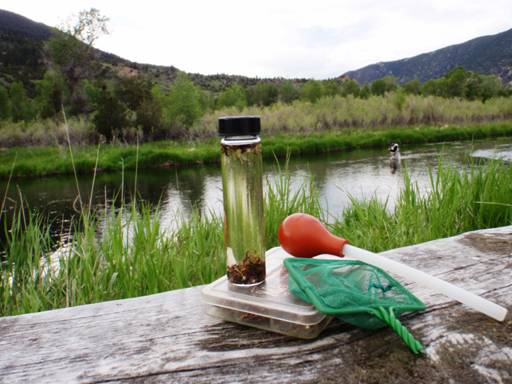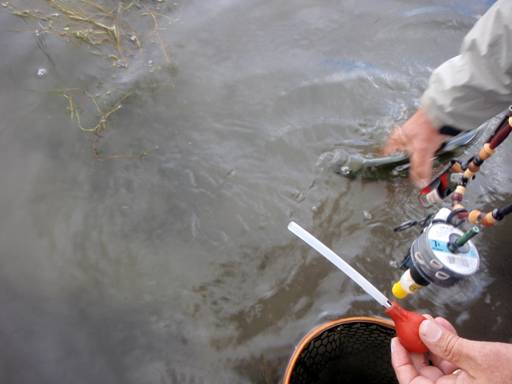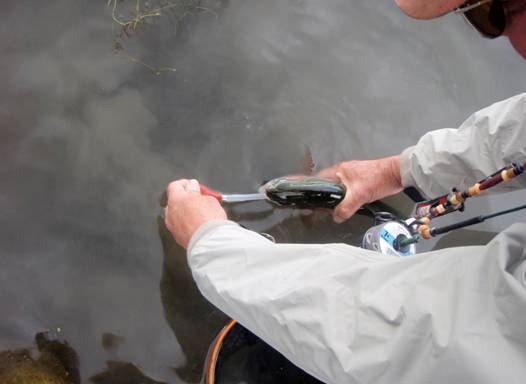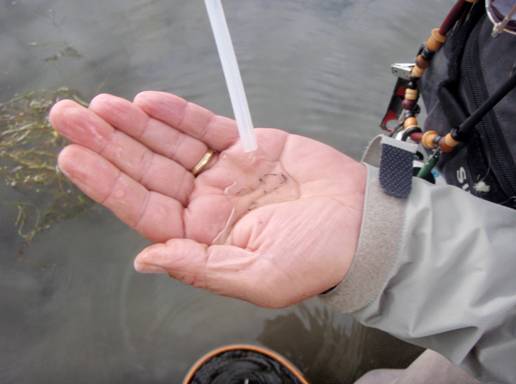EVENINGS ALONG THE STREAM (part 14)
| Sysadmin Note |
|---|
| Part thirteen can be found here |
July 6th, today I spent the day photographing insects and trout along the spring creek. Some trout were caught and their stomach sampled and I spent some time photographing the trout in their natural underwater world which is really neat. I also photograph the stomach samples. I would like to tell you about what I believe are some of the most important tools in the angler's vest that can be used for problem solving.

The Most Important Tools in the Angler's Vest
To many this means their collection of fly boxes, and though a well rounded fly selection is important, it is only one of part of the puzzle. The most important tool that the angler processes is his powers of observation and his mind.
However, there are a couple of other tools that the angler should have in the vest and they consist of a stomach pump and a small insect net. I also carry a bottle that is filled with 90% ethanol and 10% white vinegar. The white vinegar helps preserve the color on most but not all of the food forms collected.
Yes, I freely admit that I collect and identify insects on every stream that I fish, on those that I fish all the time I collect years of samples and use them to build displays to educate others. On the streams that I fish only on occasion I keep samples so I can build my knowledge base on those waters. Furthermore, I use all manner of stream kick screens and drift nets to learn and understand the food forms that trout feed upon.
Yet again the on stream collecting is only part of solving the problems that the serious fly fisher encounters. There is no doubt that the serious angler needs to study the hatch charts and the written information on the food forms found on the waters you fish.
The small insect net and the stomach pump are two tools that I use constantly. With the small net I will sample the surface of the water to obtain a better idea of what the fish are feeding on, and this means that at times I will approach a fish from below and position myself in his feeding lane but below his position. Often the first glance or quick sampling can lead you to hasty conclusions, but once I have determine what I believe the trout are feeding on then I will tie on my choice of imitations and attempt to take the trout.
If I am successful and hook play and land the trout, then I will pump their stomach, and this will tell me if I have selected the proper imitation. I can't begin to tell you how much I have learned about what the trout eat by using a stomach pump. More than once I have found that the trout were feeding on something other than the imitation I had chosen, but with the stomach pump I was able to switch imitations and be more successful. You might say that my information comes straight from the trout's mouth. These stomach sample also allow me to compare my imitations to what the trout is actually eating and this has lead to better designed and constructed imitations.



Obtaining this on stream information throughout the day is invaluable to helping the serious angler make good decisions as various angling situations are encountered.
These tools, along with observation and an open and inquiring mind will allow the angler to solve many of the problems that are encounter on the stream. As a final note I also record what I find on the stream and in the stomachs of the trout in my fishing journal, therefore the journals themselves become a fountain of useful information.
Everywhere I travel and fish I collect insects and pump the stomachs of the trout that I catch, and I can tell without a doubt that the number of insects that fly, crawl or are blown into the water is unbelievable, and if it ends up in the water the trout eat it. Nothing is safe from their opportunistic feeding behavior. Furthermore, the sheer volume of the terrestrial odds and ends would surprise you.
During the spring of 2011 I completed and insect display for The Spring Creek Specialist Fly Shop, which is located on the upper end of DePuy's Spring Creek. To do so I went through fifteen years of stomachSamples dating from April to late October and there wasn't a day that an ant, beetle, bee, wasp, fly, or moth didn't end up in the belly of a trout. The point that I am trying to make is that we are always aware of ant flights, beetle infestations and the like, but the trout see many more terrestrial than that and readily feed on them. That is a fact that the serious angler should always keep in the back of their mind when considering the options that are considered when streamside, and no trout are showing.
The care and time that it takes me to collect, observe or pump stomachs is well spent as I or my clients are generally more successful than others.
| Sysadmin Note |
|---|
| Part fifteen can be found here |
